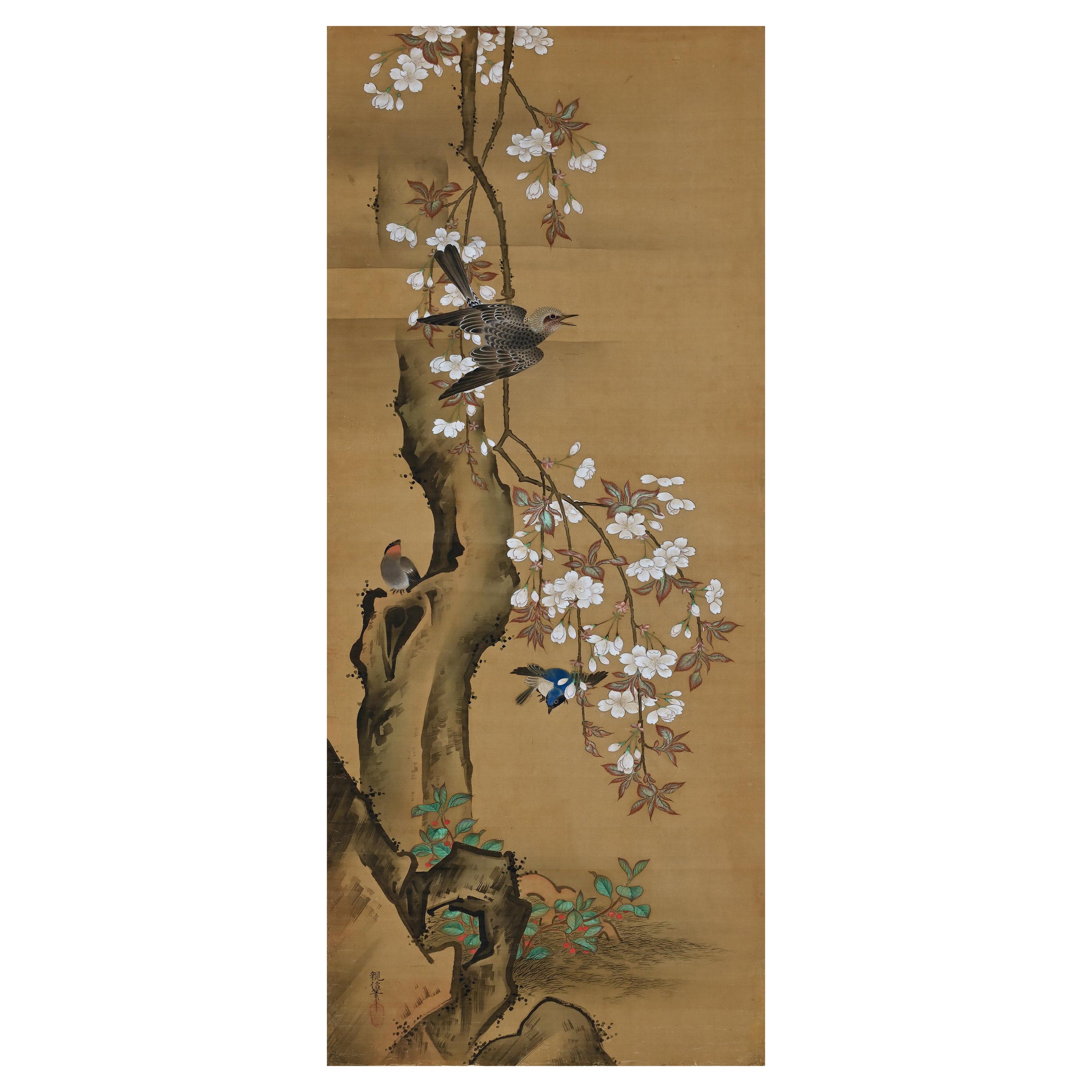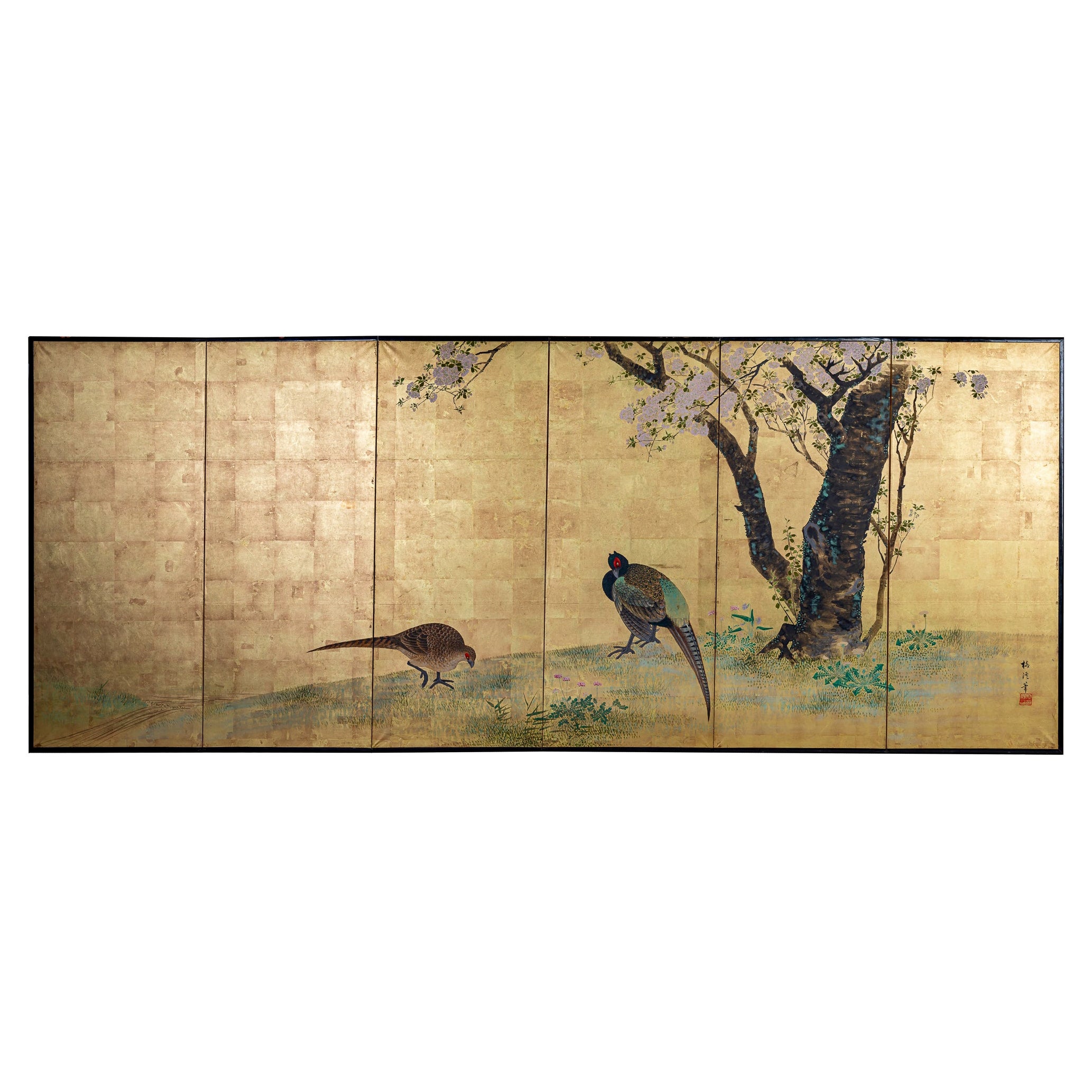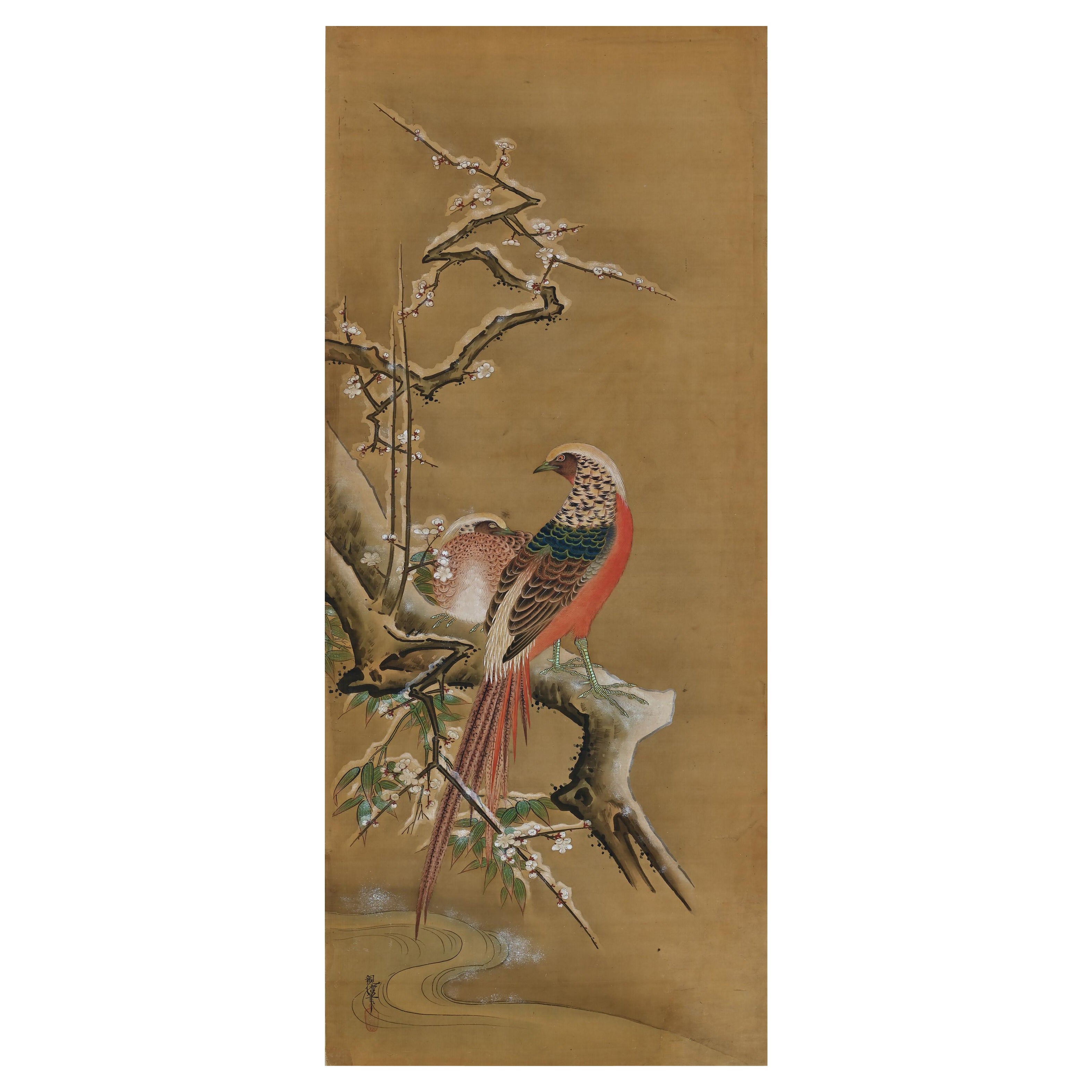Items Similar to Early 19th Century Japanese Screen. Cherry Blossom & Pheasants by Mori Tetsuzan
Want more images or videos?
Request additional images or videos from the seller
1 of 8
Early 19th Century Japanese Screen. Cherry Blossom & Pheasants by Mori Tetsuzan
About the Item
Mori Tetsuzan (1775-1841)
Pheasants and Cherry Blossoms
Two-fold Japanese screen. Ink, color, gofun, gold and silver on paper.
A two-fold Japanese bird and flower screen by the 19th century artist Mori Tetsuzan. The pheasants are rendered in a highly realistic style, owing to Tetsuzan’s careful observation of birds in nature. The delicate cherry blossoms and red leaves are also highly naturalistic, as is the twisting of the tree’s trunk and branches. These are gracefully contrasted with the simplified suggestions of the surrounding landscape, sparingly indicated and obscured by clouds of gold. Tetsuzan presents a warm world that captures the idyllic scenery in early spring. The scene encapsulates the popular Kyoto-based Maruyama-Shijo School style of painting in its fine balance of beautiful, deceptively simple design and detailed surface description.
Like his teacher, Maruyama Okyo, Tetsuzan largely eschewed painting phoenixes, dragons and other mythological creatures, as his interest lay in the world around him. He tried to capture the charm of everyday scenes. Depicted here are a pair of Green Pheasants, the national bird of Japan. They inhabit the farmlands and marshes of most of Japan, and many live near villages and towns: they are a very familiar bird, particularly in pre-industrial Japan. Despite this they are not widely represented in Japanese painting, Chinese Golden and Silver Pheasants being far more common.
Mori Tetsuzan (1775-1841) was the son of Mori Shuho (brother of Mori Sosen), and succeeded the family from Sosen. Together they formed a painting school known as the Mori school that was active in the Osaka area. Tetsuzan originally studied under Sosen, but later became a disciple of Maruyama Okyo. He is known as one of the ten disciples of Okyo. Tetsuzan passed his techniques on to Mori Kansai and Mori Ippo.
- Dimensions:Height: 69 in (175.26 cm)Width: 75 in (190.5 cm)Depth: 0.75 in (1.91 cm)
- Style:Edo (Of the Period)
- Materials and Techniques:
- Place of Origin:
- Period:
- Date of Manufacture:Circa 1820
- Condition:Wear consistent with age and use.
- Seller Location:Kyoto, JP
- Reference Number:1stDibs: LU2472331314422
About the Seller
5.0
Recognized Seller
These prestigious sellers are industry leaders and represent the highest echelon for item quality and design.
Established in 2001
1stDibs seller since 2016
60 sales on 1stDibs
Typical response time: 6 hours
- ShippingRetrieving quote...Ships From: Kyoto, Japan
- Return PolicyA return for this item may be initiated within 10 days of delivery.
More From This SellerView All
- Early 20th Century Japanese Cherry Blossom Screen by Kano SanrakukiLocated in Kyoto, JPCherry Blossoms Kano Sanrakuki (1898-1981) Showa period, circa 1930 2-panel Japanese Screen Color, gofun and gold leaf on paper Against a backdrop of gold-leafed ground, the lichen covered trunk and branches of the life-sized cherry blossom tree reach out and beyond the confines of the pictorial surface. The overall composition has a feeling of flatness which draws emphasis to the surface and the three-dimensionality of the cherry blossoms. Painstakingly built-up layers of thickly applied shell-white gofun detail the voluminous blossoms and cover large areas of this tour-de-force of Japanese Nihonga painting. By simplifying the background, minimizing the number of colors and depicting the blossoms with such heavy relief, the artist has emphasized the stunning presence of the cherry tree. The type of tree depicted is the Yae-Zakura; a double-layered type of cherry blossom famed for its beauty and strength. When we think of Japanese cherry blossoms, the first thing that comes to mind is Somei Yoshino variety, which has a single flower with five almost white petals. This type is fragile and easily blown away by strong wind or rain. Most of the double-flowered cherry blossoms begin to bloom when the Somei-Yoshino falls, and the flowering period lasts longer than that of the Somei-Yoshino. Kano Sanrakuki originally studied painting at the Kyoto City Arts and Crafts School under the tutelage of Yamamoto Shunkyo...Category
Early 20th Century Japanese Showa Paintings and Screens
MaterialsGold Leaf
- 19th Century Japanese Silk Painting by Kano Chikanobu, Cherry Blossom & BirdsLocated in Kyoto, JPBirds & flowers of the seasons Pheasants & plum in snow Unframed painting. Ink, pigment and gofun on silk Kano Chikanobu 1819-1888 Signature...Category
Antique Mid-19th Century Asian Edo Paintings and Screens
MaterialsSilk
- Japanese Screen Painting, Early 19th Century, Autumn Flowers by Sakai HoitsuLocated in Kyoto, JPA two-fold Japanese screen by the Rimpa school artist Sakai Hoitsu (1761-1828), Japan, 19th century, Edo period. This small Japanese folding screen pai...Category
Antique Early 19th Century Japanese Edo Paintings and Screens
MaterialsWood, Silk
- 19th Century Japanese Silk Painting by Kano Chikanobu, Pheasants & Plum in SnowLocated in Kyoto, JPBirds & Flowers of the Seasons Pheasants & Plum in Snow Ink, pigment and gofun on silk Kano Chikanobu 1819-1888 Signature: Chikanobu Seal: Shateki Offered here is an unframed ‘kacho-e’ painting by the 19th century Japanese Takamatsu domain painter Kano Chikanobu. There are 8 individual paintings available, which originally would have been part of a set of 12. ‘Kacho-e’ literally means ‘pictures of birds and flowers’. In reality it covers a wide range of natural motifs including birds, fish, insects and small animals in combination with flowers, grasses or trees. The theme has a long history in Japanese painting. It is one of three painting genres, the other two being landscape and figure, which derive from Chinese academic painting classification. As one of the accepted types of painting to be shown in official residences, scenes of birds, flowers and animals were rife with metaphorical reference as well as physical beauty. In these paintings Chikanobu has made conspicuous use of brilliant pigments and meticulous brushwork. The rocks, water, trees, blossoms, and birds are treated as stylized formal elements in a grand design. All of the components contribute to the patterned effect and tactile richness of the surface. Beyond their highly decorative qualities, the subject of some of the paintings are also an allusion to imperial allegiance; the pheasants are symbolic of bravery and steadfastness, peacocks represent divinity and power, and the phoenix paired with paulownia a just and benevolent ruler. Cranes and turtles symbolize longevity, and the lush, full bloom of the peony flower represents wealth and opulence. Paintings of native Japanese birds and flowers were appreciated primarily for their evocation of the seasons and the traditional poetic emotions associated with them. This is the case with the spring scene of cherry blossoms and birds and the winter scene of narcissus, nandina and sparrows. The rich expression of flower and bird paintings...Category
Antique Mid-19th Century Asian Edo Paintings and Screens
MaterialsSilk
- Japanese Scroll Painting, 19th Century Chinese Pheasants by Yoshizawa SetsuanLocated in Kyoto, JPChinese Pheasants Yoshizawa Setsuan (1809-1889) Hanging scroll, ink and color on silk. Painting inscription: Setsuan Houyou Upper seal: Y...Category
Antique Mid-19th Century Asian Meiji Paintings and Screens
MaterialsSilk
- Japanese Screen, 19th Century, Rabbits and Horsetail Reeds on Silver LeafBy NenmaLocated in Kyoto, JPUnknown artist Rabbits and Horsetail Reeds Painted in the Year of the Fire Dog, 1826 or 1886. 19th century. The scene depicted here is set under moonlight, with two hares hi...Category
Antique Mid-19th Century Japanese Edo Paintings and Screens
MaterialsSilver Leaf
You May Also Like
- Japanese Six Panel Screen with Hotei, Edo Period, Early 19th CenturyLocated in Austin, TXA delightful Japanese six panel painted paper screen featuring the beloved figure Hotei, Edo Period, early 19th century. Hotei, called Budai in China, and known as the Laughing Buddha or Fat Buddha in the West, is considered to be an emanation of Maitreya, the Buddha of the Future. In Japan, he also holds a special place as one of the Seven Lucky Gods, being the god of fortune, and protector of children. He is always portrayed as a mirthful and corpulent man, dressed in loose robes that show off his round belly. He carries a sack with him, said to be filled with treasure. As the protector of children, he is often portrayed with them playing on or around him, as he is here. The children portrayed in this screen are dressed in Chinese style clothing...Category
Antique Early 19th Century Japanese Edo Paintings and Screens
MaterialsSilk, Paper
- Japanese Six Panel Screen: Pheasants Beneath Flowering CherryLocated in Hudson, NYMineral pigments on gold leaf. Signature and seal read: Baikei Hitsu.Category
Antique Late 19th Century Japanese Paintings and Screens
MaterialsGold Leaf
- Japanese Silk Scroll Painting of Moneys Edo Period Mori TetsuzanLocated in Atlanta, GAA Japanese mounted vertical hanging scroll painting by Mori Tetsuzan (Japanese, 1775-1841) circa 19th century Edo period. The watercolor and ink on silk ...Category
Antique 19th Century Japanese Japonisme Paintings and Screens
MaterialsSilk, Paper
- Early 19th Century Japanese Six-Panel Screen, Tropical GardenLocated in Hudson, NYWith a banana leaf palm on the left, at water's edge with geese. Perhaps a scene from the southern islands. Mineral pigments on mulberry paper with gold leaf and a silk brocade border.Category
Antique Early 19th Century Japanese Paintings and Screens
MaterialsGold Leaf
- 19th Century Japanese Edo Six Panel Kano School Landscape ScreenLocated in Rio Vista, CALate Edo period 19th century Japanese six-panel landscape screen featuring a cypress tree over a flowering hibiscus with a pair of hototogisu birds. Kano school painted with ink and ...Category
Antique 19th Century Japanese Edo Paintings and Screens
MaterialsSilk, Wood, Paper
- Japanese Two Panel Screen, Cherry Blossoms in Willow LandscapeLocated in Hudson, NYDramatic and beautifully executed cherry blossoms trickle down the two panels with natural willows calmly coexisting with luminous gold dust fading to the ground. Mineral pigments an...Category
Antique Mid-19th Century Japanese Paintings and Screens
MaterialsGold
Recently Viewed
View AllMore Ways To Browse
Japanes Birds
Japanese Birds
Industrial Japanese
Early 19th Century Simple Furniture
Green Blossom
Cherry And Gold
Hand Painted Blossom
The Pheasant
Japanese Landscape Screen
Antique Cherry Color
Chinese Paper Screens
Japanese Silver Leaf
Chinese Screen Circa
Asian Paintings Of Birds
Antique Pheasant
Antique Pheasants
Paper Folding Screen
Papered Folding Screen





